Abstract
1. Capsazepine has recently been described as a competitive capsaicin antagonist. We have used this compound to test the hypotheses that the in vitro and in vivo effects of capsaicin are due to interactions with a specific receptor. 2. In an in vitro preparation of the neonatal rat spinal cord with functionally connected tail, the activation of nociceptive afferent fibres by the application of capsaicin, bradykinin or noxious heat (48 degrees C) to the tail could be measured by recording a depolarizing response from a spinal ventral root. Application of capsaicin or substance P to the spinal cord also evoked a depolarizing response which was recorded in a ventral root. 3. When capsazepine (50 nM-20 microM) was administered to the tail or spinal cord it did not evoke any measurable response. However on the tail, capsazepine reversibly antagonized (IC50 = 254 +/- 28 nM) the responses to capsaicin but not to heat or bradykinin administered to the same site. Similarly capsazepine administration to the spinal cord antagonized the responses evoked by capsaicin (IC50 = 230 +/- 20 nM) applied to the cord but not responses evoked by substance P on the cord or by noxious heat and capsaicin on the tail. 4. In halothane anaesthetized rats, C-fibre responses evoked by transcutaneous electrical stimulation of the receptive field were recorded from single wide dynamic range neurones located in the spinal dorsal horn. C-fibre evoked discharges were consistently reduced by the systemic administration of capsaicin (20 mumol kg-1, s.c.) and this action of capsaicin was antagonized by capsazepine (100 mumol kg-1) administered by the same route.(ABSTRACT TRUNCATED AT 250 WORDS)
Full text
PDF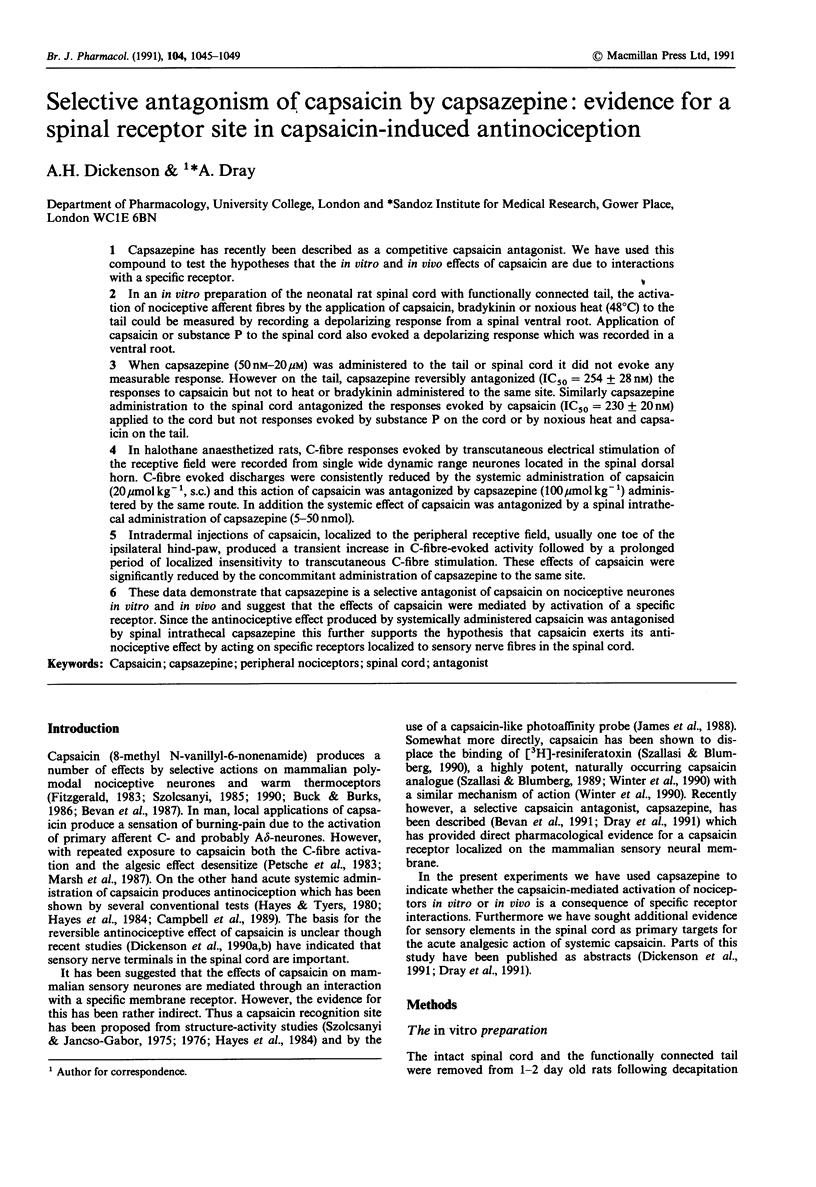
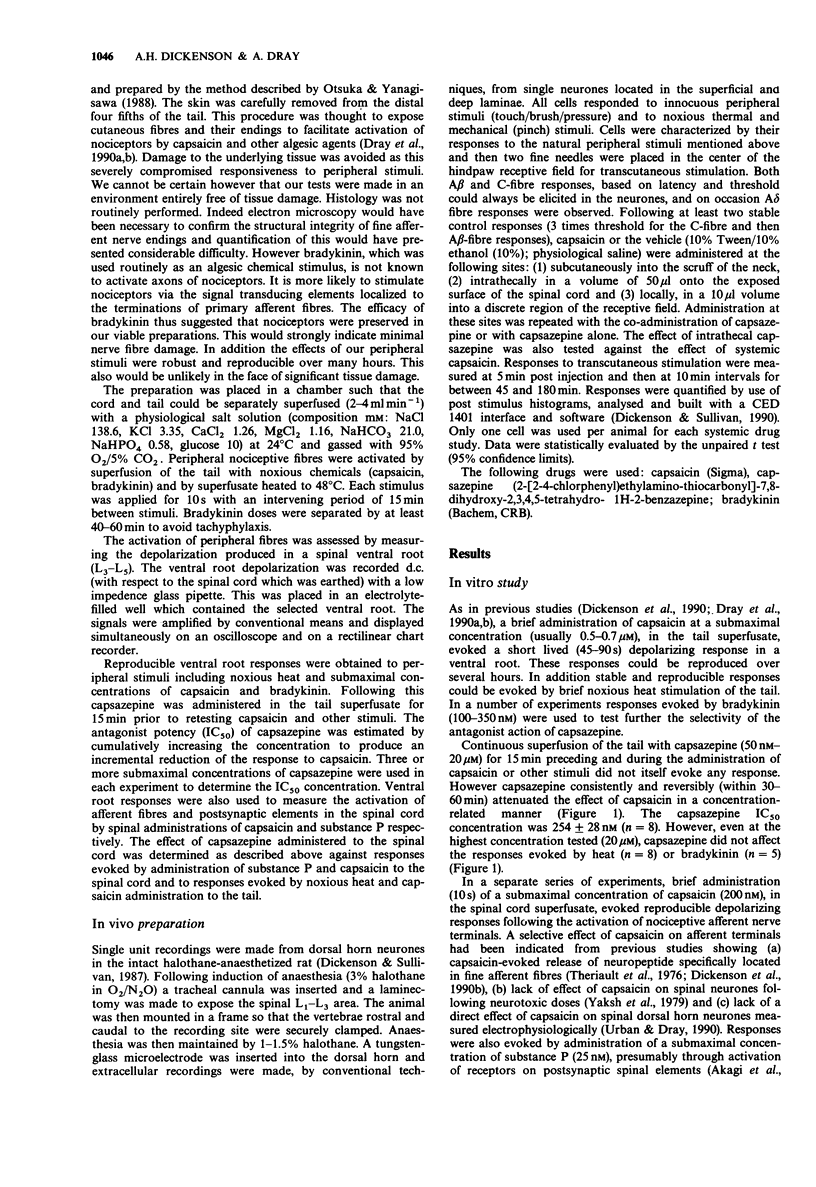
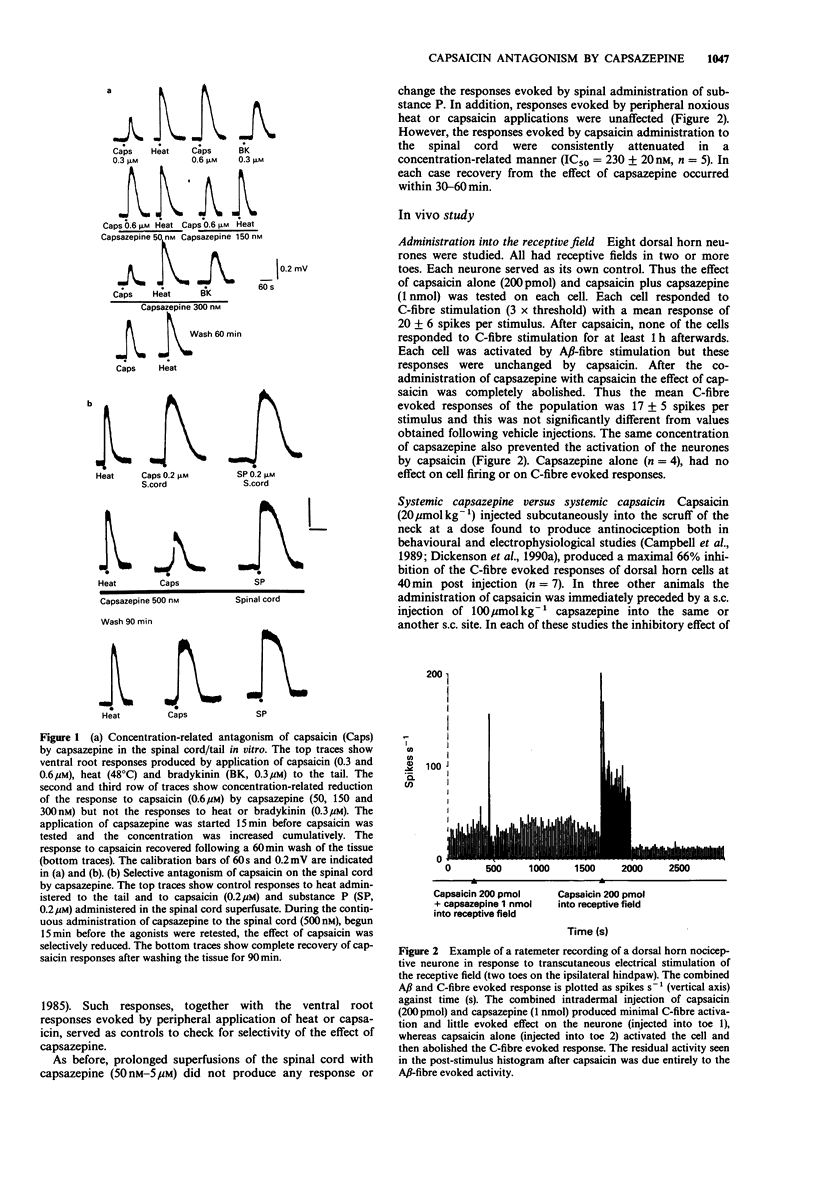
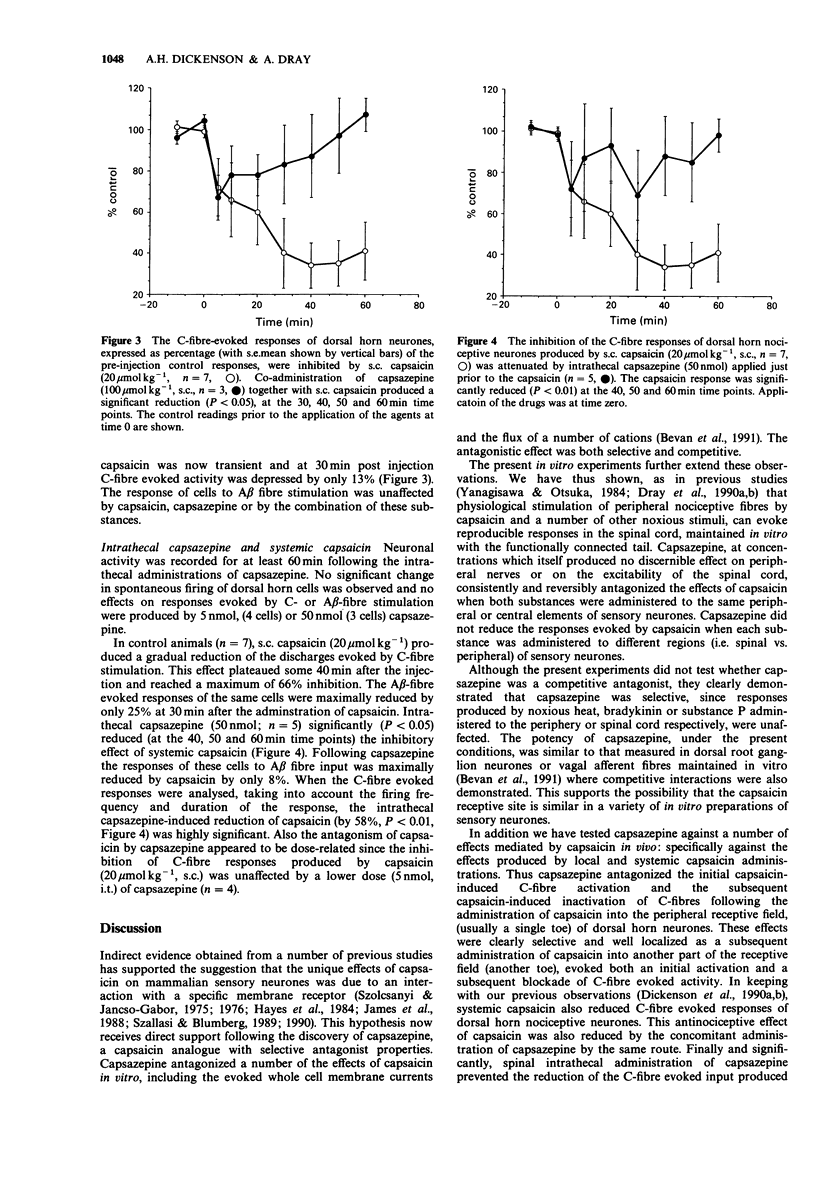
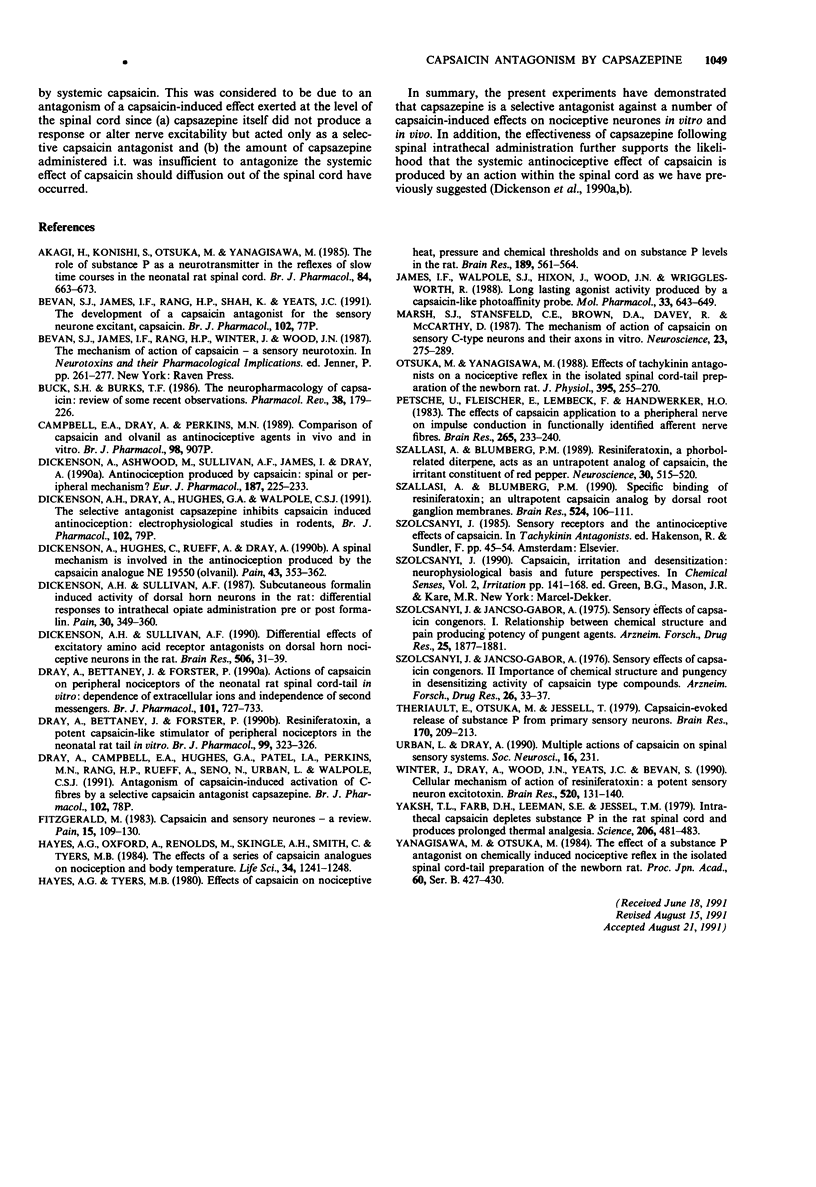
Selected References
These references are in PubMed. This may not be the complete list of references from this article.
- Akagi H., Konishi S., Otsuka M., Yanagisawa M. The role of substance P as a neurotransmitter in the reflexes of slow time courses in the neonatal rat spinal cord. Br J Pharmacol. 1985 Mar;84(3):663–673. doi: 10.1111/j.1476-5381.1985.tb16148.x. [DOI] [PMC free article] [PubMed] [Google Scholar]
- Buck S. H., Burks T. F. The neuropharmacology of capsaicin: review of some recent observations. Pharmacol Rev. 1986 Sep;38(3):179–226. [PubMed] [Google Scholar]
- Dickenson A. H., Sullivan A. F. Differential effects of excitatory amino acid antagonists on dorsal horn nociceptive neurones in the rat. Brain Res. 1990 Jan 1;506(1):31–39. doi: 10.1016/0006-8993(90)91195-m. [DOI] [PubMed] [Google Scholar]
- Dickenson A. H., Sullivan A. F. Subcutaneous formalin-induced activity of dorsal horn neurones in the rat: differential response to an intrathecal opiate administered pre or post formalin. Pain. 1987 Sep;30(3):349–360. doi: 10.1016/0304-3959(87)90023-6. [DOI] [PubMed] [Google Scholar]
- Dickenson A., Ashwood N., Sullivan A. F., James I., Dray A. Antinociception produced by capsaicin: spinal or peripheral mechanism? Eur J Pharmacol. 1990 Oct 9;187(2):225–233. doi: 10.1016/0014-2999(90)90009-u. [DOI] [PubMed] [Google Scholar]
- Dickenson A., Hughes C., Rueff A., Dray A. A spinal mechanism of action is involved in the antinociception produced by the capsaicin analogue NE 19550 (olvanil). Pain. 1990 Dec;43(3):353–362. doi: 10.1016/0304-3959(90)90032-9. [DOI] [PubMed] [Google Scholar]
- Dray A., Bettaney J., Forster P. Actions of capsaicin on peripheral nociceptors of the neonatal rat spinal cord-tail in vitro: dependence of extracellular ions and independence of second messengers. Br J Pharmacol. 1990 Nov;101(3):727–733. doi: 10.1111/j.1476-5381.1990.tb14148.x. [DOI] [PMC free article] [PubMed] [Google Scholar]
- Dray A., Bettaney J., Forster P. Resiniferatoxin, a potent capsaicin-like stimulator of peripheral nociceptors in the neonatal rat tail in vitro. Br J Pharmacol. 1990 Feb;99(2):323–326. doi: 10.1111/j.1476-5381.1990.tb14702.x. [DOI] [PMC free article] [PubMed] [Google Scholar]
- Fitzgerald M. Capsaicin and sensory neurones--a review. Pain. 1983 Feb;15(2):109–130. doi: 10.1016/0304-3959(83)90012-x. [DOI] [PubMed] [Google Scholar]
- Hayes A. G., Oxford A., Reynolds M., Shingler A. H., Skingle M., Smith C., Tyers M. B. The effects of a series of capsaicin analogues on nociception and body temperature in the rat. Life Sci. 1984 Mar 26;34(13):1241–1248. doi: 10.1016/0024-3205(84)90546-0. [DOI] [PubMed] [Google Scholar]
- Hayes A. G., Tyers M. B. Effects of capsaicin on nociceptive heat, pressure and chemical thresholds and on substance P levels in the rat. Brain Res. 1980 May 12;189(2):561–564. doi: 10.1016/0006-8993(80)90369-8. [DOI] [PubMed] [Google Scholar]
- James I. F., Walpole C. S., Hixon J., Wood J. N., Wrigglesworth R. Long-lasting agonist activity produced by a capsaicin-like photoaffinity probe. Mol Pharmacol. 1988 Jun;33(6):643–649. [PubMed] [Google Scholar]
- Marsh S. J., Stansfeld C. E., Brown D. A., Davey R., McCarthy D. The mechanism of action of capsaicin on sensory C-type neurons and their axons in vitro. Neuroscience. 1987 Oct;23(1):275–289. doi: 10.1016/0306-4522(87)90289-2. [DOI] [PubMed] [Google Scholar]
- Otsuka M., Yanagisawa M. Effect of a tachykinin antagonist on a nociceptive reflex in the isolated spinal cord-tail preparation of the newborn rat. J Physiol. 1988 Jan;395:255–270. doi: 10.1113/jphysiol.1988.sp016917. [DOI] [PMC free article] [PubMed] [Google Scholar]
- Petsche U., Fleischer E., Lembeck F., Handwerker H. O. The effect of capsaicin application to a peripheral nerve on impulse conduction in functionally identified afferent nerve fibres. Brain Res. 1983 Apr 18;265(2):233–240. doi: 10.1016/0006-8993(83)90337-2. [DOI] [PubMed] [Google Scholar]
- Szallasi A., Blumberg P. M. Resiniferatoxin, a phorbol-related diterpene, acts as an ultrapotent analog of capsaicin, the irritant constituent in red pepper. Neuroscience. 1989;30(2):515–520. doi: 10.1016/0306-4522(89)90269-8. [DOI] [PubMed] [Google Scholar]
- Szallasi A., Blumberg P. M. Specific binding of resiniferatoxin, an ultrapotent capsaicin analog, by dorsal root ganglion membranes. Brain Res. 1990 Jul 30;524(1):106–111. doi: 10.1016/0006-8993(90)90498-z. [DOI] [PubMed] [Google Scholar]
- Szolcsányi J., Jancsó-Gábor A. Sensory effects of capsaicin congeners I. Relationship between chemical structure and pain-producing potency of pungent agents. Arzneimittelforschung. 1975;25(12):1877–1881. [PubMed] [Google Scholar]
- Szolcsányi J., Jancsó-Gábor A. Sensory effects of capsaicin congeners. Part II: Importance of chemical structure and pungency in desensitizing activity of capsaicin-type compounds. Arzneimittelforschung. 1976;26(1):33–37. [PubMed] [Google Scholar]
- Theriault E., Otsuka M., Jessell T. Capsaicin-evoked release of substance P from primary sensory neurons. Brain Res. 1979 Jul 6;170(1):209–213. doi: 10.1016/0006-8993(79)90957-0. [DOI] [PubMed] [Google Scholar]
- Winter J., Dray A., Wood J. N., Yeats J. C., Bevan S. Cellular mechanism of action of resiniferatoxin: a potent sensory neuron excitotoxin. Brain Res. 1990 Jun 18;520(1-2):131–140. doi: 10.1016/0006-8993(90)91698-g. [DOI] [PubMed] [Google Scholar]
- Yaksh T. L., Farb D. H., Leeman S. E., Jessell T. M. Intrathecal capsaicin depletes substance P in the rat spinal cord and produces prolonged thermal analgesia. Science. 1979 Oct 26;206(4417):481–483. doi: 10.1126/science.228392. [DOI] [PubMed] [Google Scholar]


